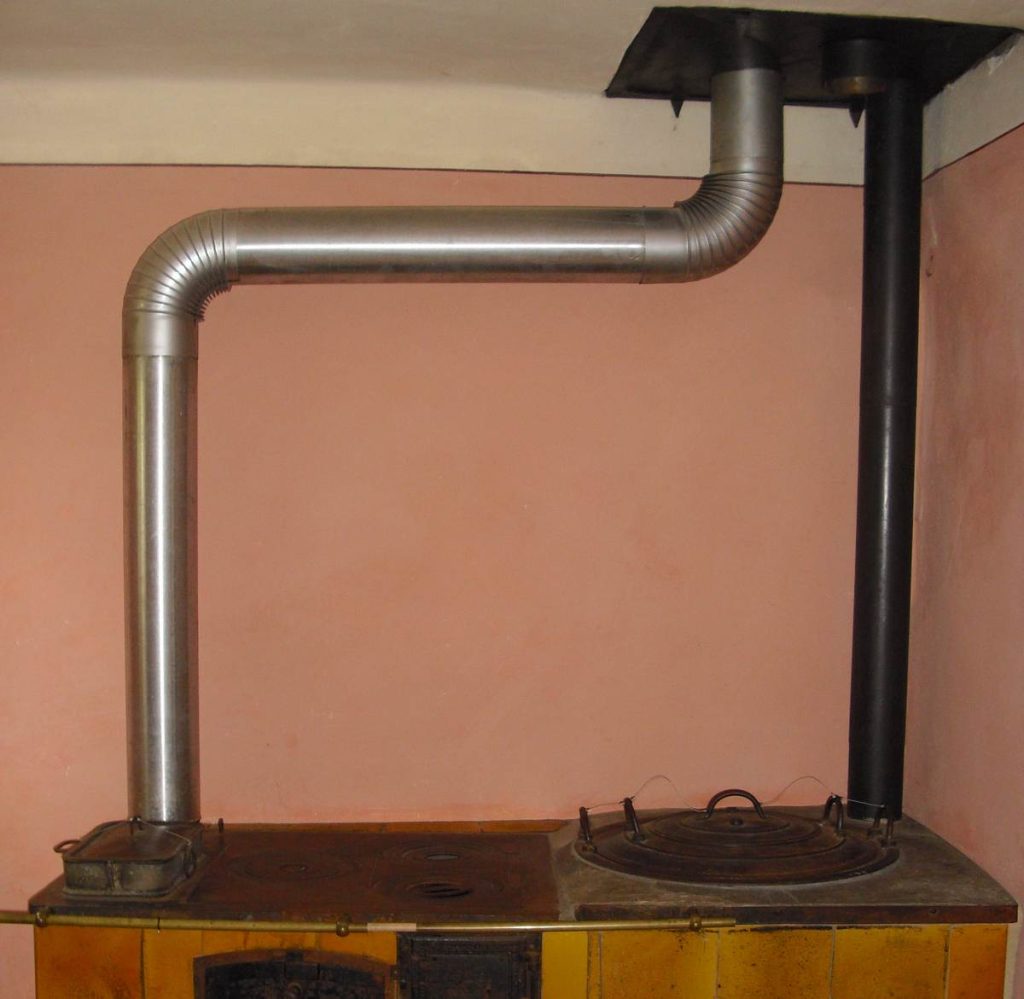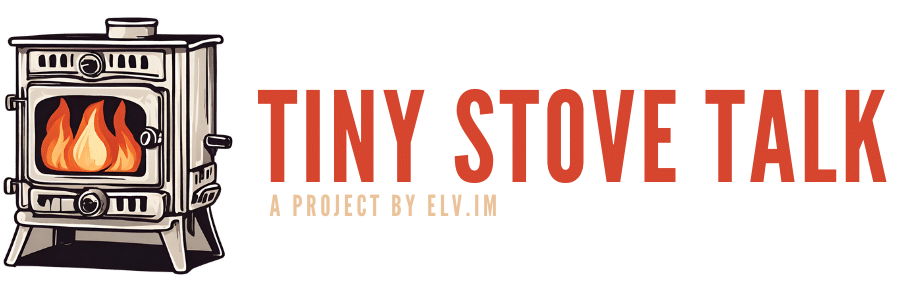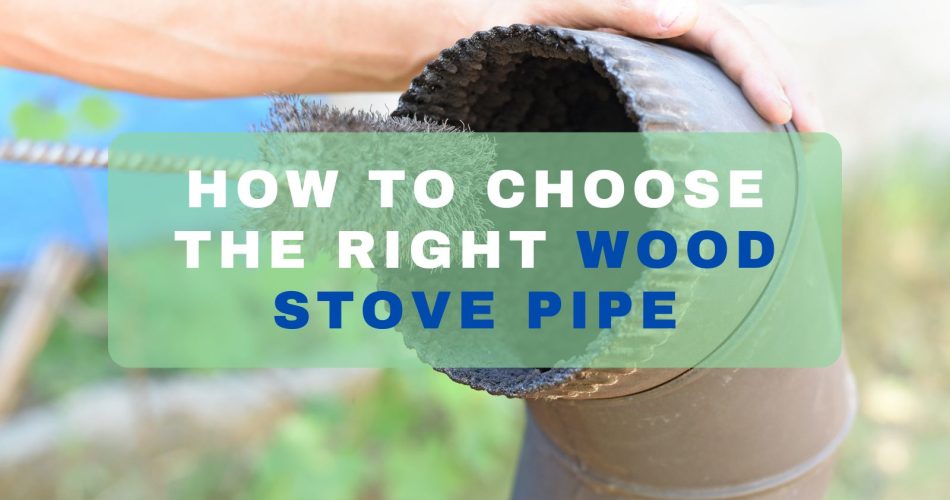Those cold winter nights made me mount a CB-1008 Cubic Mini Wood Stove in my home. That process taught me the importance of the best wood stove pipe — an often overlooked component. It’s crucial for keeping harmful gases out. But it’s just as important to keep things efficient and safe.
After some trial and error (and definitely some success), I finally got through those maze-like chimney pipes. And now I’m here to share my insights into choosing with you. Here’s what we’ll be going over:
So, you can optimize your stove’s performance while keeping everything safe and up-to-code.
Best Wood Stove Pipe for Chimneys

But first, before we dive into chimney pipes for wood stoves, let’s quickly compare the three common types:
Single-wall Chimney Pipes
My journey started with picking between single-wall and double-wall chimney pipes. The single wall had a simple metal layer, initially very inviting because of its affordability and straightforward installation. However, they require 18 inches of clearance from combustibles, which posed a huge challenge since I have limited space.
Double-wall Chimney Pipes
The double-wall chimney pipe was a revelation due to its dual metal layers and insulating air gap. With this option, they could reduce their clearance requirement to just 6 inches, which fit perfectly around my Cubic Mini since they were working with snug quarters. It also greatly improved my stove efficiency as it retained more heat, optimizing draft and warmth distribution better!
Triple-wall Chimney Pipes
I didn’t need this in my setup for now. But I wanted to learn about its design since it has plenty of benefits. For example:
- Three layers of metal and insulation make it incredibly safe and reliable — especially in places with harsh climates or where maximum fire safety is crucial.
- Superior insulation reduces clearance even further, which effectively helps optimize stove efficiency in colder temperature environments. It is something that people who live in regions with extreme winters would be grateful for.
Applications & Selection: Tailoring to Your Needs
It was an immensely difficult balancing act between:
- Spatial constraints
- Budget considerations
- Desired efficiency
A single-wall pipe would’ve been great since they were much more cost-effective, but you must always consider what fits your living space best. In my case, I did not really need the triple-wall, so I went with a double-wall pipe instead.
Wood Stove Pipe Materials
Finally, there’s the choice of material — stainless steel or galvanized steel?
Stainless Steel — Toughness & Corrosion Resistance
You’ve probably seen this stuff everywhere because of how tough it is. It can withstand all sorts of abuse without rusting away, too! That’s why stainless steel was my top choice when I made my pick since it can handle various moisture and acidic conditions around my area.
Stainless steel pipes, for example, are highly resistant to corrosion and are suitable for long-term use, especially in harsh weather conditions.
A fact
Galvanized Steel — Lower Cost but Lower Longevity Too
Yes, the price on this one may be lower, but so is its long-term resistance against corrosion. It is especially so for me since the Cubic Mini can produce different types of combustion by-products!
So, if you ever find yourself stuck at a crossroads deciding between these two materials, always base your decision on these factors instead:
- Installation budget
- Local environmental conditions
- Expected lifespan
To combat these problems, I decided to use the best wood stove pipe, one that was made of stainless steel. The portions facing outward were also made of stainless steel to stand against Mother Nature’s fury. Although it was more expensive, but using stainless steel gave me peace of mind.
Understanding Chimney Pipe Insulation
As I was looking to maximize the efficiency of my stove, I quickly saw the importance of insulation in chimney pipes. It was crucial to keep the exhaust gases hot so that I could improve the draft and hinder creosote buildup. The process involved deciding between the following:
Air-Insulated Pipes
- Compatibility with Wood Stoves: Air-insulated pipes work with most wood stoves. They’re built using two layers of metal, and between those layers is an air gap. This design keeps the outer surface of the chimney cool by reducing the clearance from any combustible materials you might have nearby.
- Cost: When compared to solid-insulated pipes, air-insulated are generally cheaper. They are great for homeowners who need performance without breaking the bank. You should still note that while they may be cheaper at first, their long-term costs could be increased if they aren’t maintained properly or installed correctly.
- Durability: Their durability is based on the materials used and how well they were made. The air gap protects them but is still vulnerable to corrosion over time if not made with a strong inner layer. Just like anything else, you’ll want to make sure it’s inspected regularly and maintained to ensure its longevity.
Solid-Insulated Pipes
- Compatibility with Wood Stoves: Solid insulated pipes are going to give you a lot more peace of mind than other options out there. They offer excellent compatibility with even the strongest drafts and highest temperature tolerance wood stoves on the market today. With these chimneys, you’ll find a layer of insulation material like fiberglass or ceramic between their inner and outer walls, which helps keep heat within them.
- Cost: Expect to pay more upfront for something this good. These types of pipes are on the high end when it comes to pricing but are absolutely worth every penny if your home needs optimal performance in colder climates.
- Durability: You won’t have any issues here as long as you don’t live in a volcano. It’s built tough enough for high temperatures and will last longer than most other options on this list.
Combination-Insulated Pipes
- Compatibility with Wood Stoves: If none of these other options fit what you’re looking for, you might want to consider this one. The hybrid design is compatible with almost everything. This makes it perfect for installations that need optimal performance but can’t afford to take up too much room.
- Cost: It’ll be a little more expensive than the others on this list, but if your home needs it, you’ll have no issue justifying it. I’d say it’s worth every penny with how well it’s made and all the safety features they’ve put in place here.
- Durability: Normally, you would need two different materials to make something like this work. However, they found a way to combine both insulation types into one item. With how well these things are built, I can guarantee they won’t go anywhere anytime soon.
So, after the comparison above, I finally decided to go with a double-wall air-insulated pipe! This type offers a balance between cost-effectiveness and efficiency. Perfect for maintaining a strong draft and operating a Cubic Mini Wood Stove safely.
Wood Stove Pipe Compatibility
It’s not as simple as it may sound at first to ensure that chimney pipes are compatible with wood stoves. You need to pay close attention to several factors if you don’t want to fail like me regarding my CB-1008 Cubic Mini Wood Stove (I’ll be using it as an example throughout this guide). Now, let’s dive deeper into each aspect to understand how they all affect our selection of the best wood stove pipe.
Output of the Stove
The size and type of chimney pipe depend on only one thing… the output of your stove! Most commonly reported in BTUs (British Thermal Units), my compact-sized CB-1008 Cubic Mini has a much smaller output than that of larger models.
So, I can get away with smaller-diameter chimney pipes due to less overall volume. However, you must ensure that this diameter matches up perfectly with the flue collar on your stove, or else you’ll have a poor draft and inefficient burning because you are oversized.
Type of Fuel It Uses
Different kinds of fuel require different types of chimney pipes! My CB-1008 Cubic Mini is designed specifically for burning wood — just like most wood stoves — but that doesn’t save me from trouble.
There are still problems to face, like creosote buildup, which can be dangerous if not maintained properly! Some stoves are designed for pellets or coal, while others will burn any type. So, pick the best wood stove pipe built around whatever your stove requires because each fuel source produces different heat and by-products!
Design of the Heating System
Now that we’re past the stove, let’s think big and look at the heating system… After all, it will only make sense with such a small-sized stove. And one day, you’ll see how perfect it is in smaller areas or as a supplementary heat source.
To accommodate this lifestyle of mine, I chose a double-wall insulated chimney pipe so that I could have reduced clearance requirements. This means installing the stove closer to furniture than normal without sacrificing my safety.
But if you’re into detail like me, you’d also consider whether a vertical or horizontal run would work better (we went with vertical since it leads to better draft and efficiency).
Catalytic vs. Non-Catalytic Stoves
The CB-1008 Cubic Mini is a non-catalytic stove. That doesn’t sound so important, but it is when looking at chimney pipe compatibility. Catalytic stoves use a catalyst to burn off smoke and emissions so the world won’t fill up with smog.
However, they need a way to manage lower temperatures in the pipe, or the draft will come out, and the smoke will come back down. Non-catalytic stoves like the CB-1008 have high combustion temperatures to maintain efficiency.
So obviously, they’ll need a pipe that can handle higher heat without melting away; this will keep the draft strong enough for complete combustion of all fuel.
Optimizing Performance and Safety
Choosing a chimney pipe for the CB-1008 meant more than just picking something that fits. It was about ensuring the stove’s performance wasn’t affected and remained safe. A properly matched chimney encourages a strong draft in your stove.
This draft is necessary for efficient burning and less creosote buildup — one of the leading causes of chimney fires. You can find this information in the manual or consult with a professional.
By optimizing performance and safety, homeowners can get as much use out of their heating system as possible while keeping themselves safe. This high level of attention to detail between wood stove performance and their safety is how homeowners find harmony.
Installation Considerations for Wood Stove Pipes
Knowing how these pipes work when being installed can make all the difference in your wood stove’s performance and your home’s overall safety. My installation of the Cubic Mini has brought up multiple
important considerations that everyone should know before they start this task, such as:
Route of the Chimney Pipe
The path that the chimney pipe takes from the stove to the outside can greatly affect efficiency and safety levels throughout your house. In my case, I chose an option that took my Cubic Mini’s chimney pipe vertically because I needed optimum draft results. This setup helps with consistency, allowing gas from smoke to increase more naturally due to thermal drafts.
When you take this route, there isn’t any resistance slowing down this process either, which will give you better performance and reduce buildup risks caused by creosote. Of course, not every house layout allows you to go straight up, so sometimes going horizontal is necessary.
In those situations, you must run horizontally with as little space as possible and slope them upwards towards the exit to get the draft altitude required for efficient operation.
Length of the Chimney and Elbows
The size of your chimney needs careful thought, along with any turns it makes. Each turn risks slowing down your smoke flow, which means less draft, and that’s something you don’t want. I ensured minimal elbows to keep things smooth for my Cubic Mini’s exhaust gases.
Keeping things short and sweet isn’t just a good way to enhance drafts. It can also help you lower risks of creosote accumulation — a common cause of chimney fires.
The Effects of Installation Choices
A few problems can happen if you mess up the installation. For one, dangerous gases could be building up inside your home. If there’s too much creosote buildup, it might cause a chimney fire to spark. Believe it or not, messing this up can even lead to breaking some laws.
I’ve worked with wood-burning stoves before and learned that avoiding these risks is as easy as following the manufacturer’s guidelines. I’m not really the safety-first type, but here are the basics:
- The pipe should never bend more than 30 degrees from vertical.
- Screws alone shouldn’t hold everything together and don’t shove anything into place.
- If you’re having trouble moving something in there, it won’t go. That’s why select factory-built and UL-listed or certified pipes. They have better specifications and quality.
Professional Installation Matters
I do pretty well with DIY projects, but when it came time to install my chimney pipe–I knew getting professionals involved was essential. Their knowledge of local codes and expertise in certain fields makes them an invaluable resource for those who don’t trust themselves with such an important task like myself.
In my case, consulting with a pro ensured that the Cubic Mini’s chimney was installed to precise specifications so it performed optimally and safely. It is particularly important for installations involving complex routing or when the stove and chimney system are integrated into an existing structure.
Safety Standards for the Best Wood Stove Pipe
Following the manufacturer’s installation guidelines isn’t enough! You must also comply with local building codes and safety standards because they can vary drastically depending on where you live.
Not only is compliance required by law, but it also has a huge impact on your insurance policy as well as how much someone will be willing to pay for your property once you decide to sell it. Your wood stove was designed to operate at its safest while being efficient.
There’s really no reason not to follow the rules. Ignoring or trying to bypass these standards can lead to the following:
- Owing a hefty fine
- Not getting any money from your insurance policy
- Having a higher risk of fire or health hazards
A regular certified inspection will guarantee that your stove and chimney pipe will comply with all regulations.
As I was dealing with my mini stove, I made sure to review each guideline provided by Cubic Mini. This way, I could double-check that everything met their expectations and industry standards. A lot of people take shortcuts during this process, which is what leads to dangerous risks like fire hazards or carbon monoxide exposure.
Aside from standards for chimney pipes, you should also check safety standards for wood stoves, like the EPA Regulations.
Maintaining Your Wood Stove Pipe
Even the best wood stove pipe needs regular care to remain at peak performance. While your tube may be built to last, it does not mean you should skip out on its maintenance—especially if you want it to last. Below are some ways you can maintain your pipe for long use:
- Regular Checkups: Inspect your chimney pipe at least once a year, ideally before the winter season begins. Look for signs of damage like rust, cracks, or leaks.
- Keep It Clean: Creosote buildup is a fire hazard. Clean your chimney often to get rid of soot and creosote. If you always use your wood stove, clean it more regularly.
- Use the Right Tools: Investing in a chimney brush that matches the shape and size of your pipe will help cleaning be more effective and less annoying.
- Protect From Rust: A metal chimney pipe is prone to rusting over time. Check if there’s any rust on yours, then apply a high-temperature resistant paint to prevent moisture from corroding it further and extend its life.
- Make Sure There’s Enough Draft: Good airflow is essential for chimneys. Poor airflow leads to creosote buildup and inefficient burning, which can pose many problems. If you have issues with how quickly smoke goes out of your house, call an expert right away!
- Put On Your Cap: Chimney caps keep rain, snow, and debris from entering your home through the chimney opening without restricting airflow.
- Avoid Burning Wet Wood: Using wet or unseasoned wood increases creosote buildup by a lot. Always use dry and seasoned wood for cleaner burning instead!
- Seal Those Joints Tight: Go around each section of your pipe, checking if they’re properly sealed so air doesn’t escape into other parts of your home!
- Educate Yourself: Knowing how something works makes fixing issues much easier! Read up on your fireplace maintenance guidelines to learn how to maintain it correctly.
- Professional Help: When in doubt, don’t hesitate to call someone who knows what they’re doing better than you do
Different designs require different types of care, and so do different materials. Stainless steel pipes may resist rust better than galvanized ones, but they will still deteriorate if not properly handled.
Improvements Over The Years
The chimney industry has seen many improvements over time that have significantly increased safety, efficiency, and ease of installation. For instance:
- New alloys are being developed to make wood-burning pipes more durable and corrosion-resistant.
- Insulation methods increase a pipe’s efficiency while reducing clearances.
These advancements not only make heating with wood safer but also help preserve our environment by improving efficiency while decreasing emissions at the same time.
Mistakes I Learned in Choosing Wood Stove Pipe
Many errors could lead to failure when installing a chimney pipe for wood-burning stoves. Let’s take a lot of some of these mistakes that I learned as I went along this journey:
Need for Space
One of the most common mistakes is simply not giving themselves enough space. If you don’t give your stove and chimney the right amount of room away from combustible material, there could be serious
consequences. I was so eager to try my new Cubic Mini that I didn’t leave enough clearance between my new toy and the walls. The heat from the pipe transfer easily set fire to any nearby object it touched. You should always follow safety clearances and never skimp on them. When in doubt, go with more than you need!
The Wrong Type of Wood Stove Pipe
When I first chose the best wood stove pipe for my chimney, I was first decided on the single-wall pipe. It was less expensive, and I thought it would not be a hassle since it was just one ‘wall’ of difference. But, if I had done that, the efficiency of my stove would have gone way down while the heat would just be pushed into other rooms.
That seems like a lose-lose for me. So always ensure you pick the right one based on your requirements and specific situations.
For example, if you want to save costs, then go for double or triple-wall chimney pipes. They are a bit expensive, but they already have built-in insulation.You will save more in the long run. Don’t think about making this decision without deep thought, though, because being cheap now will only cause problems later.
Improper Sealing of Wood Stove Pipe
Sealing all connections between every single component should be a no-brainer. But sometimes, people don’t realize there’s a minor leak because they’re just so into it. I didn’t care about how well I sealed the connections early on.
This carelessness led to small leaks and made my stove draft perform poorly. Not only that, but these leaks allow gases from combustion to enter your home, which is a serious health risk. So, ensure every joint is sealed with high-temperature sealant because it boosts the overall performance and safety of the system.
Conclusion
Picking the best wood stove pipe for your chimney has more to it than just connecting A and B. In your selection, you must ensure you choose a safe, energy-efficient, and long-lasting option. It will include considering the following:
- What type of pipe do you have
- What it’s made of
- How well-insulated it is
- What is your environment
You also need to ensure you comply with safety standards and building codes. These standards and codes will help keep you and the people around you safe. You may think it’s complicated now, but it will be worth it later!
Few tricks n tips you should know if you are working with your wood stove pipes
Improving Draft
To enhance the draft in a wood stove pipe, ensure it rises straight up from the stove before any horizontal runs. The vertical rise should be at least 12 to 15 feet to establish a strong natural draft. Additionally, insulating the pipe or using a double-wall pipe for the exterior portion can keep the gases warmer and improve draft efficiency.
Sealing Joints
Properly sealing the joints between sections of the wood stove pipe can significantly reduce the risk of smoke leakage into the room. High-temperature silicone sealant or specialized gaskets designed for wood stove pipes can be used to create airtight seals, ensuring that all combustion gases are safely vented outside.
Regular Cleaning
To prevent creosote buildup, a highly flammable byproduct of wood combustion, it’s crucial to clean wood stove pipes regularly. Using a chimney brush that matches the size and shape of the pipe, you can dislodge and remove creosote deposits. This not only reduces the risk of chimney fires but also maintains optimal airflow and efficiency in the wood stove system.
Questions you might have after reading this article
How does the efficiency of a wood stove and its pipe impact the overall heating costs in a cabin or home?
The efficiency of a wood stove and its pipe can significantly influence heating costs by affecting the amount of fuel required and heat retention. Efficient systems minimize waste and cost less to operate over time.
Are there any innovative or new materials being developed for wood stove pipes that offer better performance or sustainability than stainless or galvanized steel?
Innovations in materials for wood stove pipes could potentially offer better durability, heat efficiency, and environmental benefits. Research into such materials could be ongoing.
How does the choice of wood stove pipe affect the resale value of a property, if at all?
The installation of high-quality and efficient wood stove pipes might enhance a property’s appeal to certain buyers, potentially impacting its resale value positively.
Can the installation of certain types of wood stove pipes qualify homeowners for any energy efficiency rebates or tax credits?
Certain energy-efficient installations, including wood stove pipes, might be eligible for rebates or tax credits, depending on local regulations and the specific products used.
What are the long-term environmental impacts of using wood stoves and specific types of pipes, considering emissions and fuel sourcing?
The environmental impact of wood stoves and their pipes includes considerations of emissions and sustainable fuel sourcing. Choosing efficient systems and responsibly sourced wood can mitigate some environmental concerns.
Additional Resources
Ready to get started on your selection of the best wood stove pipe for your chimney? Here are some pipes and accessories you can consider:



Comments